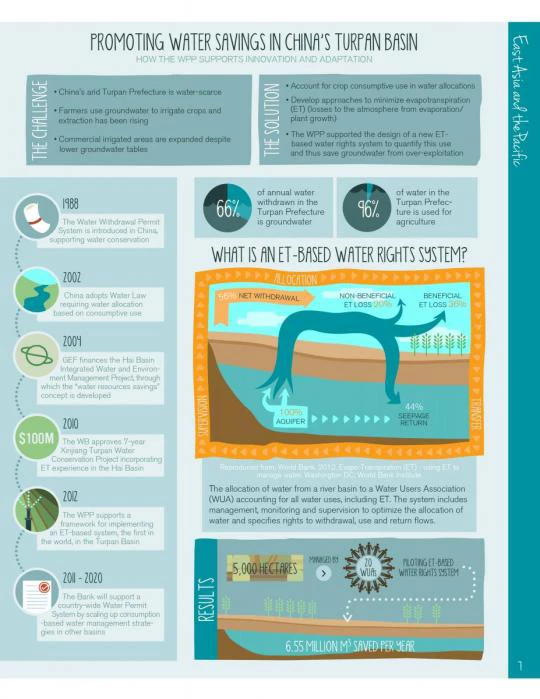Also available in: 中文
China’s most arid regions are facing an increasingly serious water crisis, and local water policies often aggravate the problem. In such climates, growth in the agricultural sector has come with high environmental costs.
With the help of new technologies that measure real water consumption in agriculture, governments are designing innovative water rights systems that actually save water. Based on results from two successful pilots, the World Bank Group is partnering with China to tap into science to transform water management in agriculture at the national level.
Conserving Water in China’s Hottest and Driest Place
The latest pilot supports the Turpan Prefecture in China’s Xinjiang Uygur Autonomous region, which is one of the country’s most water-stressed (annual evaporation is 200 times higher than annual precipitation) and poorest regions.
Despite the parched climate, irrigated agriculture, which is the largest water user, continues to expand. The area under irrigation increased nearly two-fold between 1970 and 2008, from 60,000 ha to 113, 000 ha. During that same time, groundwater tables in Turpan dropped by 1.5 to 2 meters per year causing a series of environmental problems, such as degradation of ecological oases and loss of cultural heritage water supply systems.
Overexploitation of groundwater was partly because of the quota-based water rights system in Turpan, based on “use it or lose it” principles. Farmers had incentives to consume as much water as they were entitled to. Even with the use of more efficient irrigation technologies, any water that was “saved” was used to develop more land, not returned to the soil, groundwater, or nearby lakes and streams.
More land under irrigation uses more water, and not just the crops. Plants consume water through a process called transpiration, which together with evaporation from water bodies can be measured as evapo-transpiration (ET) – all the water that goes from the land surface into the air. The portion of water lost to ET can be even higher than the amount used to grow the crops. For example, in China’s Hai Basin, 98% of water is consumed by ET processes.
Water allocation policies that account for ET are especially important in dry climates. To help local authorities in the Turpan Basin implement an ET-based water rights system, the World Bank‘s Water Partnership Program (WPP) piloted the implementation of an innovative ET-based Water Rights Administration System (WRAS) in the Turpan Prefecture on a small scale.
This system applied remote sensing technologies for measuring and monitoring ET via satellite data. The new measurements were used to develop consumption targets, which, together with basin-wide development plans, formed the basis of water allocation decisions. The system sets the maximum amount of water that can be used for economic activities without damaging the ecological environment and without groundwater overdraft.
 The
new ET-based WRAS is ready for implementation in the larger basin-wide area through the
Xinjiang Turpan Water Conservation Project. The system will build upon the existing legal and administrative water rights system but will incorporate allocation, reallocation, transfer, and supervision to meet water consumed by ET and other economic and ecological uses. The project also replicates lessons from the World Bank’s Water Conservation Project in the Hai Basin (2000-2006), through which farmers’ annual per capita income increased by 193% and water productivity by 82%, while consumptive use or ET decreased by 27%.
The
new ET-based WRAS is ready for implementation in the larger basin-wide area through the
Xinjiang Turpan Water Conservation Project. The system will build upon the existing legal and administrative water rights system but will incorporate allocation, reallocation, transfer, and supervision to meet water consumed by ET and other economic and ecological uses. The project also replicates lessons from the World Bank’s Water Conservation Project in the Hai Basin (2000-2006), through which farmers’ annual per capita income increased by 193% and water productivity by 82%, while consumptive use or ET decreased by 27%.
Advances in remote sensing data for real-time, low-cost ET measurements has provided the data needed to assess tradeoffs and make critical decisions about the best use of limited resources. The World Bank Group has also made efforts to share these experiences with other countries, such as Brazil, Chile and Peru in Latin America; and Egypt, Jordan, Lebanon, Morocco, and Yemen in MENA that face similar challenges in maximizing agricultural production while looking at more sustainable, and more integrated water management in extremely water-scarce areas.


Join the Conversation